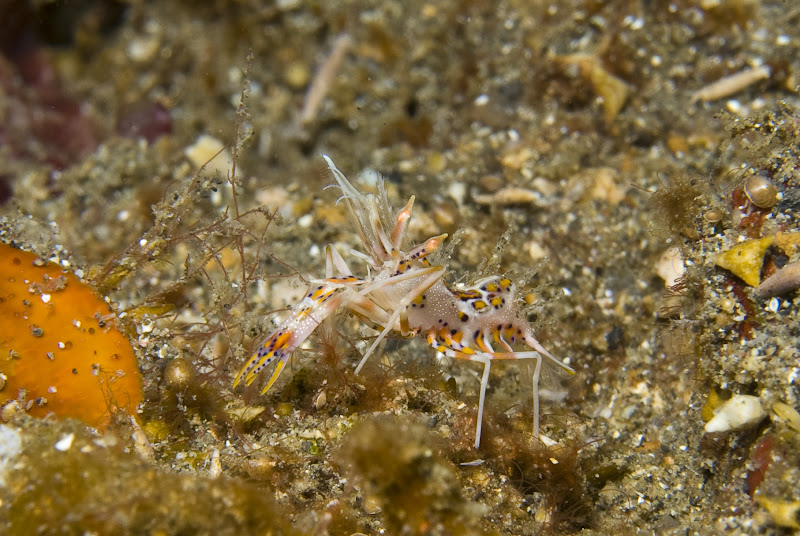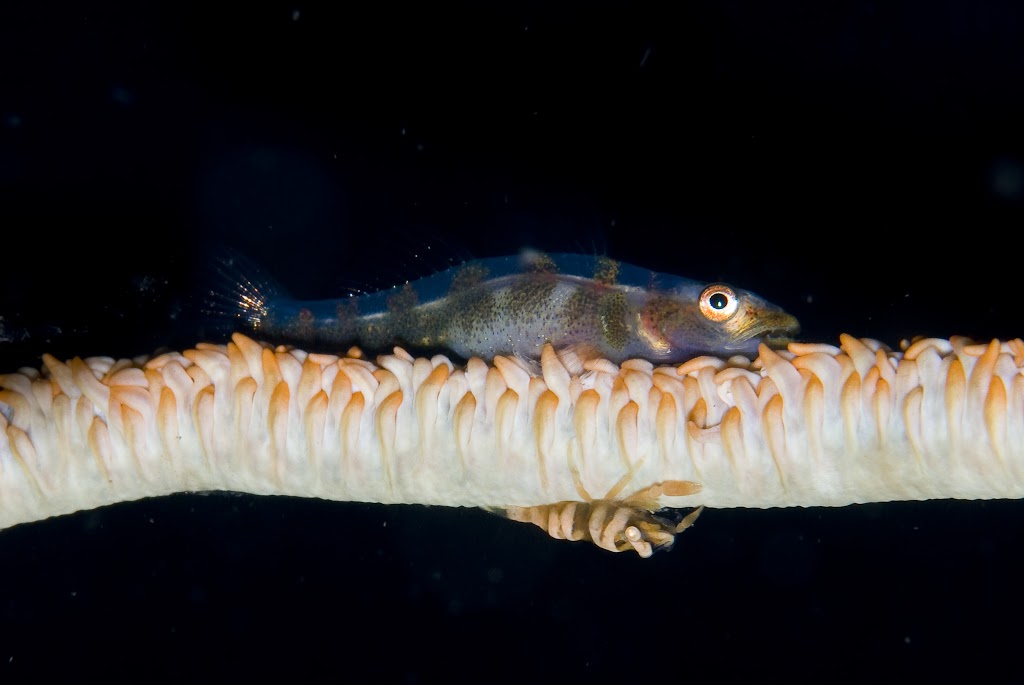
 |
Απάντηση: Lembeh Straits
Antesco αυτή η βουτιά ήταν και για εμάς προπόνηση "ακινισίας" και στωικότητας!!!
Αλλά ναι το θέαμα άξιζε όλη την αναμονή :):) |
Απάντηση: Lembeh Straits
Like George said, the absolute highlight of this trip was seeing the Blue Ringed Octopus. It was first seen by the other boat in the morning and i have to admit that i was cursing my luck at NOT been in the same boat...
Luckily, Lembeh is a generous place and it took care of us too......... the octopus is in fact incredibly small... and quite fearless. It seemed not to mind our presence and went about its business like nothing out of the ordinary was going on. Our guides were ecstatic at having seen it.... they were high-fiving each other underwater making hooping sounds and the celebrations continued on the boat as well.....  The above is display mode. the rings are prominent  During travel the rings were not as prominent.  and here, having become one with the background, it is hopping that the bothersome, noisy, people will go away... You can find more info about this little critter here: http://en.wikipedia.org/wiki/Blue-ringed_octopus |
Απάντηση: Lembeh Straits
Shrimps, Shrimps everywhere!
Together with crabs, shrimps are some of the most common species you encounter in Lembeh. However, they come in such astonishing variety in colour, size, body structure, and habitats that they are impossible to tire of them.  This is the Shaw Blade shrimp (Tozeuma armatum). I was very excited to see this wonderful species that had completely escaped me in my first visit. The name is truly onomatopoeic.  A Plumed shrimp (Leander plumosus). An other wonderfully bizarre species that is characterised by the rostrum that is flat and full of cirri, or tufts of hair. Legs are almost transparent and the shrimp looks like it floats and not walk.  The tiny and jewel-like Tiger shrimp (Phyllognathia ceratophthalmus). The second part of its latin name says everything you need to know about them!  I think that this is a species of Marbled shrimp (Saron marmoratus). I have seen larger specimens in Bali, and these are not great, but they are so easily scared and hide in the corals that spotting them and getting a good photo of them is an achievement on its onw (thanks Lazaros!)  A Ghost shrimp (Pliopontonia furtiva). Leaves inside disk anemones, pinching the flesh to create a cover for her body when feeling threatened.  My photo does not do justice to this Periclemenes venustus. It is one of the most beautiful species i have ever seen and i am sorry i did not spend more time trying to get a better shot of it.  An other species, this time very bland and monochrome, of the Shaw blade shrimp. This leaves in the sand and silt and not perched on gorgonians or corals.  After so many shrimps, i let one perform a little service on me. You can see larger sized versions of the photos in the library: http://picasaweb.google.com/sfougarisb/Lembeh2010# |
Απάντηση: Lembeh Straits
Crinoids or Feather stars are among the most colourful and attractive species in the tropics. Looking closely, you can spot some wonderful creatures that have made them home. Shrimps, crabs, even fishes.
 A Crinoid Squat Lobster (Allogalathea elegans).  A crab (cant identify the species....) raises a claw in salutation....  A Crinoid shrimp (Periclemenes cornutus)  A Featherstar clingfish (Discotrema echinophila). This is the best photo i have taken of this species. If you look closely, just bellow the gills, you will see the suction disk that is used by the fish to clink onto its host. |
Απάντηση: Lembeh Straits
Υπεροχες οι 3 τελευταιες...!
|
Απάντηση: Lembeh Straits
One of the most fascinating areas / micro-systems for exploration in the straights are the Rope or Whip corals. With length that will often exceed 3 meters, they offer purchase to an amazing assortment of creatures to live on.
This time of year, we had particularly thick plankton / particles in the water that made photography (especially with just one flash) particularly tricky. It had however the positive effect of offering the right conditions for an incredible number of creatures that feed on it.  White -lined whip Goby (Bryaninops amplus)  Sea whip Goby (Bryaninops yongei)  Xenocarcinus tuberculatus, the Rat-nosed crab. Notice how the spines and protrusions on its body match the outline of its host.  Unidentified species of commensal (?) shrimp.  On less than 10-15cm of whip coral, there are 4 Whip coral partner shrimps (Pontonides unciger), 2 Dasycaris zanzibarica, and one Xenocarcinus tuberculatus. I think that there must have been about 50 comemnsal species over the length of this particular whip coral specimen that was sitting on a sandy slope at about 17m.   Unidentified species of partner shrimp.   Like Geodive said: Look Ma! no hands! |
Απάντηση: Lembeh Straits
τελειες! :thumbup:
ειδικα αυτη με την μονομαχια στο ελ πασο....του xenocrab με τις crinoid shrimps!!!! |
Απάντηση: Lembeh Straits
Θα μας τρελάνετε... !!!
|
Απάντηση: Lembeh Straits
SUPER!!!:thumbup::thumbup:
|
Απάντηση: Lembeh Straits
:eek::eek:
wonderful shots & amazing creatures Babis !!! :thumbup: |
| Όλες οι ώρες είναι GMT +2. Η ώρα τώρα είναι 05:40. |
Powered by vBulletin® Version 3.6.8
Copyright ©2000 - 2025, Jelsoft Enterprises Ltd.